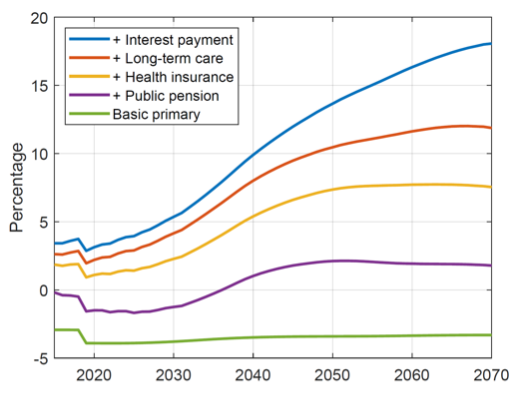Japan leads the advanced economies in the speed and magnitude of demographic ageing and has the highest debt-to-output ratio. Rising social insurance expenditures are projected to far outpace revenues and to create a fiscal burden. This column presents sobering projections for Japanese government debt in the absence of reform, but argues that a combination of policies, including policies to encourage greater labour participation by women and to enhance productivity, could achieve sustainability.
Japan is ageing fast. Its dependency ratio, defined as the ratio of the population aged 65 and above to the population aged 20-64, was 48% in 2015. It is predicted to rise to 80% by the early 2050s and to stay at around 80% during the second half of the century.
Expenditures for age-related social insurance programmes – such as pensions, public health care, and long-term care insurance – are projected to rise significantly, far outpacing the projected revenues and insurance premia collected as the size of the working age population continues to shrink rapidly. Previous research found that a major increase in taxation, in the order of 30-50% of total consumption, would be needed to finance the demographic transition without any reform (e.g. Braun and Joines 2015, Kitao 2015, Hansen and Imrohoroglu 2013); otherwise, debt will reach an unsustainable level in the not too distant future (e.g. Doi, et al 2011, Hoshi and Ito 2014).
In two papers (Imrohoroglu et al. 2016, 2018), we simulate future paths of individuals' life-time income, consumption, and saving and calculate projections of future government budget balances and debt. As in Storesletten (2003), we build a life-cycle model with complete markets to assess the impact of demographic ageing and various scenarios involving fiscal responses and economic assumptions that affect fiscal sustainability in Japan. In understanding the magnitude and consequences of demographic ageing, we allow annual deficits to be added to the existing government debt, abstracting from the possibility of default or inability to issue additional bonds.
Most importantly, we treat details of the social insurance system in Japan – including public pension, health insurance and long-term care insurance programmes – separately from other government expenditure and revenue items. We include detailed payment arrangements, as well as the system of co-pay and premium payments that differ by age, employment type, and individual earnings. It is quantitatively important to incorporate the finances of these insurance when in predicting the future paths of fiscal variables in Japan.
Projected demographic ageing in Japan implies that, without any reform or changes in the labour market, annual budget deficits will reach 10% of GDP by 2040 and 18% by 2070. The net debt-to-GDP ratio would reach the unprecedented and unrealistic level of 230% by 2040 and 630% by 2070. As shown in Figure 1, four components – expenditures for public pensions, health insurance, long-term care (LTC) programmes, and debt servicing – would contribute equally to the rising deficits and debt, with the interest payments rising more rapidly as more debt is accumulated.

So, what to tackle?
Fiscal sustainability is impossible without reform. It is also very difficult to achieve sustainability with a single tool. However, we find that a combination of policy reforms and changes in the labour market and productivity would solve the problem.
In particular, an increase in female employment (with wage increases and employment regularisation) would make a major difference. More female participation and increased earnings would not only increase income tax revenues but also the budgets of all three social insurance programmes. A major obstacle is the work disincentive and what is essentially a severe penalty for more women working that is embedded in the current social insurance policy and tax system. Efforts by policymakers to correct these mechanisms and to move in the direction of not discouraging more participation and achieving growth will be essential for long-run fiscal soundness. We note, however, that these changes require significant structural reforms and can only be implemented with a long-term and credible commitment.
Increasing the consumption tax rate from the current 8% to 10% in 2019 would reduce fiscal pressures in the short run. A further increase to a level that is comparable to other advanced economies would help alleviate significantly the accumulation of debt in the long run.
Achieving fiscal sustainability is difficult but not impossible. For example, a combination of policies such as raising the full retirement age to 67, reducing pension benefits, raising the co-pays in public medical expenditures and long-term care spending to 20%, increasing women's earnings and employment characteristics to match those of men, and raising the consumption tax rate to 15% would achieve fiscal sustainability and lead to significant fiscal consolidation with a lower debt-to-GDP ratio in 2050 than in 2020.
This article first appeared on www.VoxEU.org on June 7, 2019. Reproduced with permission.




